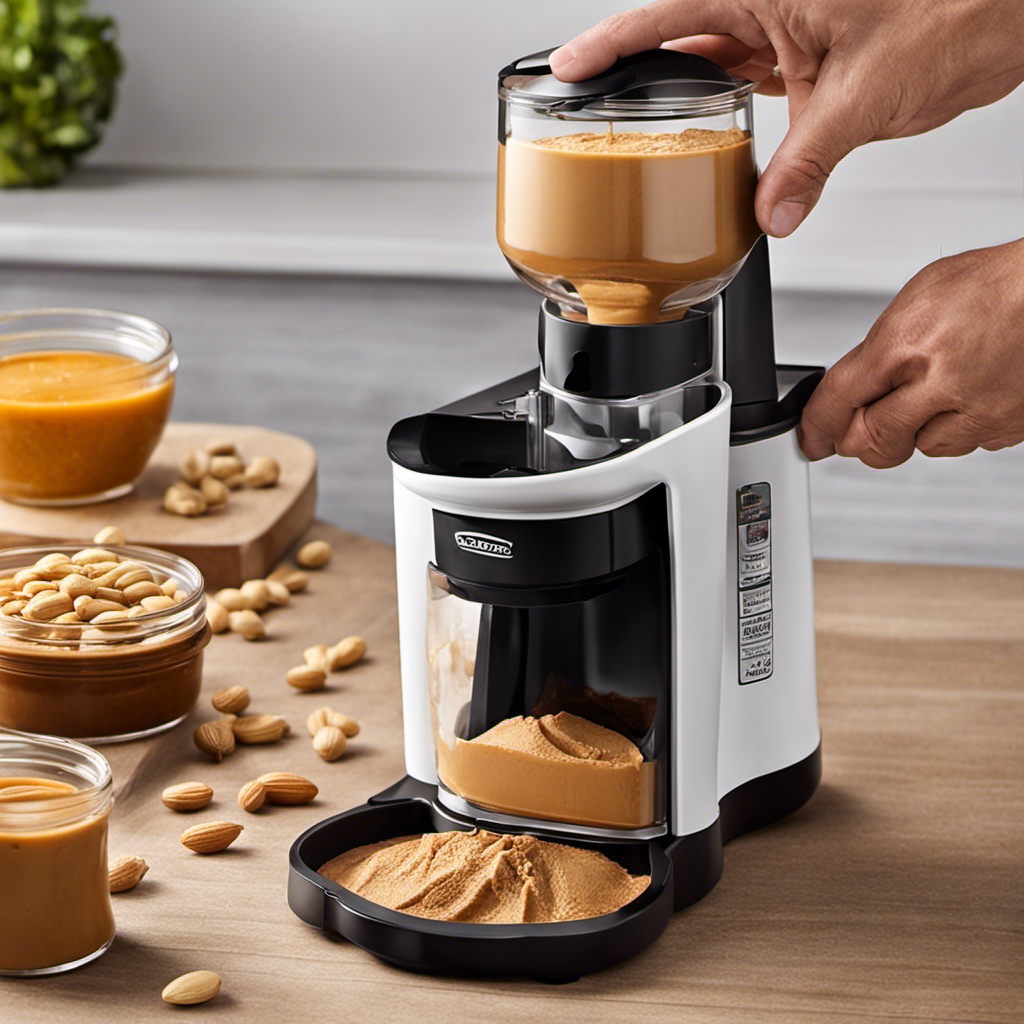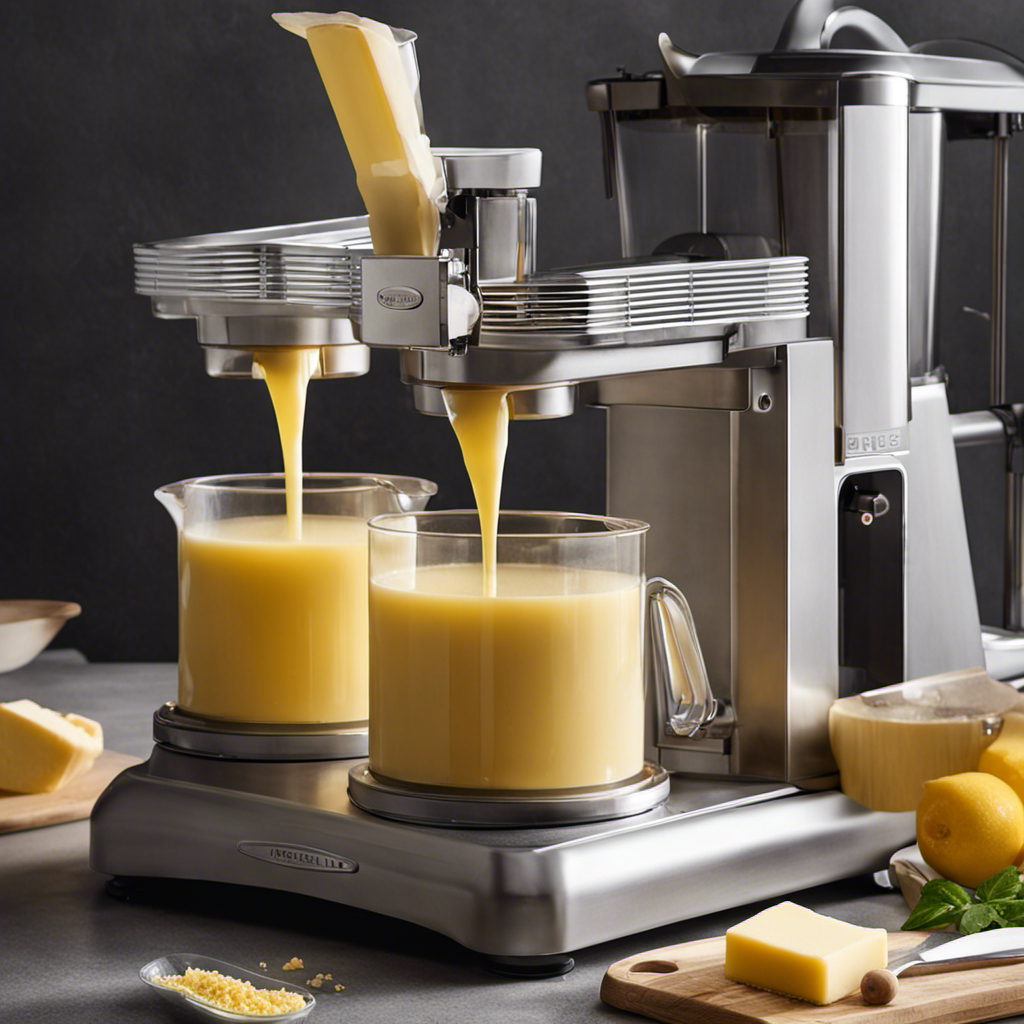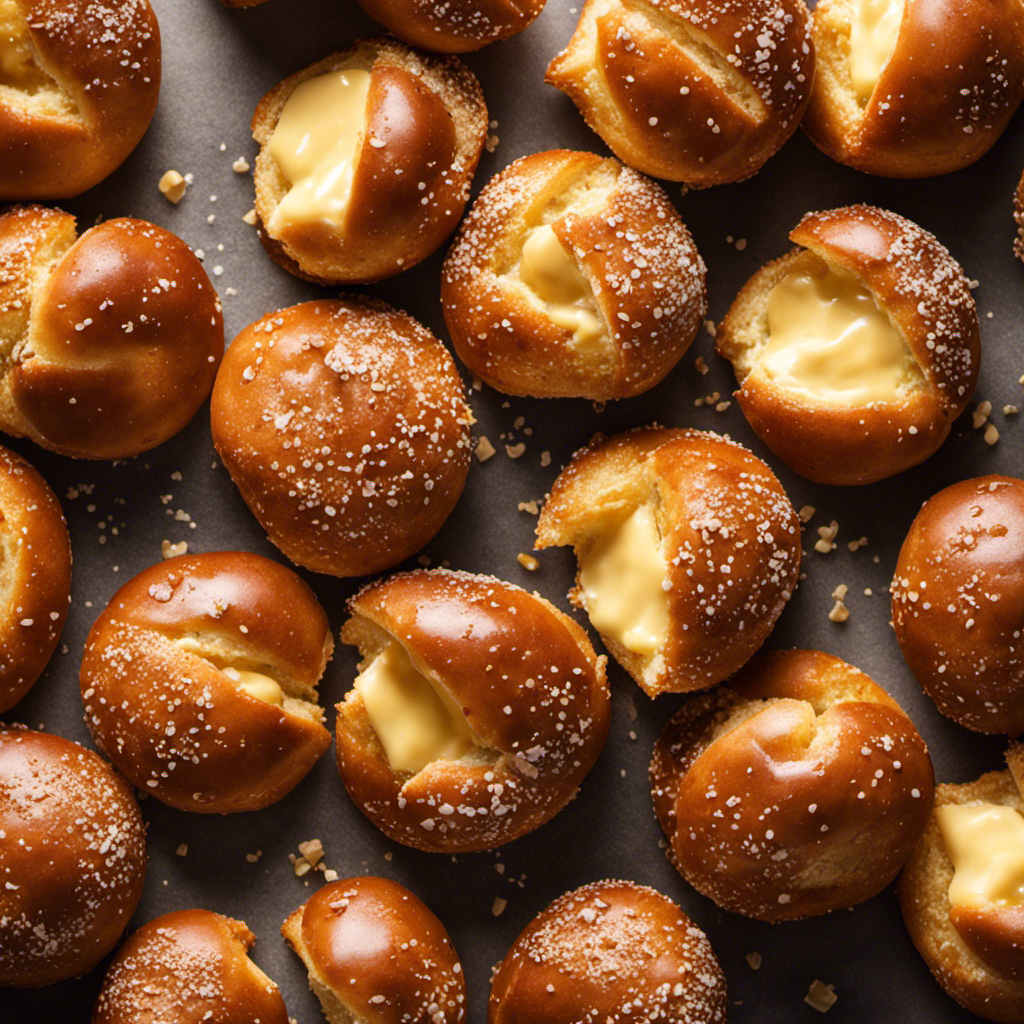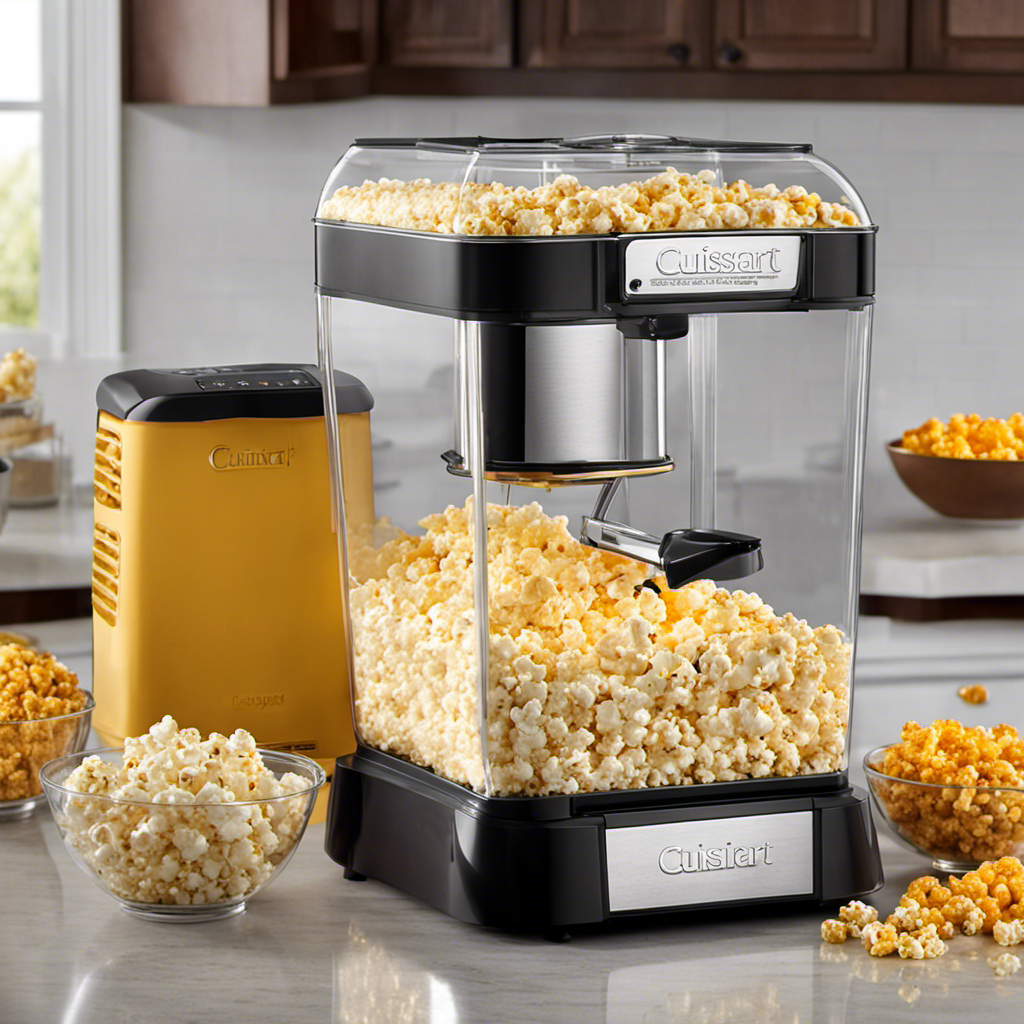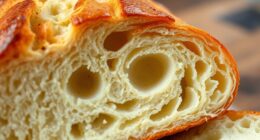You have purchased a peanut butter maker, but it does not come with an oil dispenser. Do not worry, as I will show you how to make tasty and creamy peanut butter without the need for that fancy gadget.
In this article, I’ll guide you through the process step by step, from choosing the right ingredients to adjusting the consistency just the way you like it.
Get ready to become a peanut butter pro in no time!
Key Takeaways
- There are various alternative oil dispensing methods for using a peanut butter maker without an oil dispenser, such as using a funnel or squeeze bottle with a narrow spout, a measuring cup with a spout, a small ladle or spoon, or a plastic bag with a corner snipped off.
- It is important to gradually add oil or water to achieve the desired consistency of the peanut butter, making it smoother and easier to spread, but avoiding making it too runny.
- Different liquids, such as oil or water, have different effects on the consistency of the peanut butter. Oil makes it creamier, while water makes it thinner.
- It can be helpful to refer to a table for common liquids and their effects on the consistency of peanut butter when adjusting the texture.
Choosing the Right Peanut Butter Maker
To choose the right peanut butter maker, you’ll want to consider its size, power, and durability. When it comes to choosing the right peanut butter maker, there are a few key factors to keep in mind.
First and foremost, you’ll want to consider the size of the machine. If you plan on making large batches of peanut butter, you’ll want a machine with a larger capacity.
Secondly, you’ll want to consider the power of the machine. A more powerful motor will be able to handle tougher nuts and create a smoother consistency.
Finally, durability is important for long-term use. Look for a peanut butter maker made from high-quality materials that can withstand frequent use. Additionally, some peanut butter makers offer alternative oil dispensing methods, allowing you to adjust the amount of oil to your preference.
Now that you understand how to choose the right peanut butter maker, let’s move on to understanding the ingredients and equipment needed for making delicious homemade peanut butter.
Understanding the Ingredients and Equipment
When it comes to making homemade peanut butter, having the right equipment is essential. A high-quality food processor or blender is a must, as it will allow you to achieve that creamy smooth texture.
Additionally, having a reliable oil dispenser is important for controlling the amount of oil you add to your peanut butter. Speaking of ingredients, the key to making delicious homemade peanut butter lies in using high-quality peanuts and a good oil, such as peanut or vegetable oil.
However, if you don’t have an oil dispenser, don’t worry! There are alternative methods you can use to add oil to your peanut butter, such as using a measuring spoon or slowly drizzling it in while the processor is running.
Necessary Equipment for Peanut Butter-Making
The necessary equipment for making peanut butter includes a food processor, peanuts, and a peanut butter maker. With these tools, you can create delicious, homemade peanut butter that is free from preservatives and additives commonly found in store-bought brands.
When choosing peanut butter brands, it is important to read the labels and opt for natural options that contain only peanuts and maybe a pinch of salt. Homemade peanut butter offers numerous health benefits, such as being a good source of protein, healthy fats, and fiber. It also contains essential minerals like magnesium and potassium.
Key Ingredients for Homemade Peanut Butter
You’ll need a food processor and peanuts to make homemade peanut butter. Making your own nut butters at home is not only fun, but it also allows you to control the ingredients and customize the flavors to your liking. While peanut butter is a popular choice, you can also experiment with other nuts like almonds to make homemade almond butter.
Peanut butter is not only delicious, but it also offers several nutritional benefits. It is a great source of protein, healthy fats, and important vitamins and minerals. It is packed with heart-healthy monounsaturated fats, which can help lower bad cholesterol levels and reduce the risk of heart disease. Peanut butter is also rich in fiber, which aids in digestion and helps keep you feeling full and satisfied. Additionally, it contains important nutrients like vitamin E, magnesium, and potassium.
Alternative Oil Dispensing Methods
To easily pour oil, try using a funnel or a squeeze bottle with a narrow spout. This can be especially useful when making homemade peanut butter without an oil dispenser. However, if you don’t have access to these tools, there are alternative storage methods you can try. Here are a few options to consider:
-
Use a measuring cup with a spout: This can help control the flow of oil as you pour it into the peanut butter maker.
-
Use a small ladle or spoon: While this method may take a bit more time and patience, it allows you to carefully add the oil in small increments, ensuring a smooth and creamy consistency.
-
Use a plastic bag with a corner snipped off: Fill the bag with the desired amount of oil, seal it, and then cut a small hole in one corner. Squeeze the bag to dispense the oil into the peanut butter maker.
Preparing the Peanuts for Grinding
When it comes to preparing peanuts for grinding, there are two important steps to consider: roasting the peanuts and removing the peanut skin.
Roasting the peanuts helps to enhance their flavor and aroma, giving the resulting peanut butter a rich and nutty taste. To roast the peanuts, you can simply spread them out on a baking sheet and bake them in the oven until they are golden brown.
Once the peanuts are roasted, it’s time to remove the skin. This can be done easily by rubbing the peanuts between your hands or by placing them in a clean kitchen towel and rubbing them vigorously. Removing the skin not only improves the texture of the peanut butter but also eliminates any bitterness that may be present.
Roasting the Peanuts
After roasting, the peanuts will release their natural oils, which is a crucial step in making homemade peanut butter. Roasting the peanuts not only enhances their flavor but also helps in removing the skin easily.
Here are some roasting techniques and flavoring options you can try:
-
Roasting techniques:
-
Oven roasting: Preheat the oven to 350°F (175°C). Spread the peanuts in a single layer on a baking sheet and roast for about 10-15 minutes, stirring occasionally, until they turn golden brown.
-
Stovetop roasting: Heat a skillet over medium heat and add the peanuts. Stir them continuously for about 5-7 minutes until they become golden brown.
-
Microwave roasting: Place the peanuts in a microwave-safe bowl and microwave on high for 1-2 minutes, stirring every 30 seconds until they are roasted.
-
Flavoring options:
-
Salted: Sprinkle some salt on the roasted peanuts to enhance their flavor.
-
Honey roasted: Drizzle honey over the roasted peanuts and toss them until evenly coated.
-
Spicy: Add spices like chili powder, paprika, or cayenne pepper to give the peanuts a spicy kick.
Once the peanuts are roasted, the next step is to remove their skin, which I will discuss in the next section.
Removing the Peanut Skin
You can easily remove the skin from the roasted peanuts by rubbing them between your hands. This step is essential for achieving a smooth and creamy texture in your homemade peanut butter.
Once the peanuts have been roasted to perfection, they develop a slightly crispy skin that needs to be removed. By gently rubbing the peanuts, the skin will start to peel off, revealing the inner nut. This process can be quite therapeutic, as you feel the skin separate from the nut.
Once all the peanuts have been de-skinned, you can proceed with making your peanut butter using a peanut butter maker.
Peanut butter is not only delicious, but it also offers numerous health benefits. It is a great source of protein, healthy fats, and essential nutrients. Incorporating peanut butter into your diet can help with weight management, improve heart health, and provide a steady source of energy.
With so many peanut butter recipes available, you can enjoy this versatile ingredient in both sweet and savory dishes.
Operating the Peanut Butter Maker
To operate the peanut butter maker, simply add roasted peanuts and turn on the machine. It’s a straightforward process that allows you to create your own delicious and healthy homemade peanut butter.
Here are a few things to keep in mind when using a peanut butter maker:
-
Alternative peanut butter recipes: Don’t limit yourself to just plain peanut butter. Experiment with different flavors by adding ingredients like honey, cocoa powder, or cinnamon. This will give your peanut butter a unique twist and enhance the taste.
-
Troubleshooting common issues: If you encounter any problems while using the peanut butter maker, such as the machine not grinding the peanuts properly or the consistency being too thick, try adjusting the settings. You can also add a little bit of oil or water to achieve your desired consistency.
-
Cleaning and maintenance: After each use, make sure to clean the peanut butter maker thoroughly to prevent any residue from building up. Refer to the user manual for specific instructions on how to disassemble and clean the machine properly.
Adjusting the Consistency of the Peanut Butter
If the consistency of your homemade peanut butter is too thick, try adding a small amount of liquid to achieve the desired texture. Adjusting the consistency of homemade peanut butter can be a simple process. By adding a liquid, such as oil or water, you can make the peanut butter smoother and easier to spread. However, it’s important to add the liquid gradually to avoid making the peanut butter too runny. Here is a table that shows some common liquids that can be added to peanut butter and their effects on the consistency:
| Liquid | Effect on Consistency |
|---|---|
| Oil | Creamier and smoother |
| Water | Thinner and lighter |
| Honey | Sweeter and stickier |
| Maple syrup | Richer and thicker |
Adding Flavor Variations to Your Peanut Butter
Now, let’s explore some exciting flavor variations you can add to your homemade peanut butter.
-
Sweet and Salty: Mix in a tablespoon of honey and a pinch of sea salt for a delightful combination of flavors that will satisfy your cravings.
-
Chocolate Lover’s Delight: Stir in a tablespoon of cocoa powder and a drizzle of melted chocolate for a rich and decadent twist on traditional peanut butter.
-
Spicy Kick: Add a teaspoon of chili powder or a dash of cayenne pepper to give your peanut butter a fiery kick. Perfect for those who love a little heat in their snacks.
These flavored peanut butter recipes not only add delicious taste but also enhance the texture of your homemade peanut butter. Experiment with different combinations and find your favorite flavor profile.
Whether you prefer sweet, savory, or spicy, there’s a flavored peanut butter recipe out there to suit your taste buds. So go ahead, get creative, and enjoy the endless possibilities of homemade flavored peanut butter!
Storing and Preserving Homemade Peanut Butter
When storing homemade peanut butter, it’s important to keep it in an airtight container to maintain its freshness. Storing techniques are crucial in preventing spoilage and ensuring that your homemade peanut butter stays delicious for as long as possible.
First, make sure the container you use is clean and dry to avoid any contamination. Glass jars with tight-fitting lids are ideal for storing peanut butter. They help to preserve its flavor and prevent moisture from seeping in.
It’s also a good idea to store the peanut butter in the refrigerator, as the cold temperature helps to slow down the oxidation process and extend its shelf life. Just remember to let it sit at room temperature for a few minutes before using to make it easier to spread.
With proper storage techniques, your homemade peanut butter will stay fresh and tasty, ready to enjoy whenever you want.
Now, let’s move on to troubleshooting common peanut butter maker issues.
Troubleshooting Common Peanut Butter Maker Issues
To troubleshoot common issues with your peanut butter maker, check the power cord for any loose connections or damage. If the power cord is intact, the next step is to examine the blades. Make sure they are properly inserted and securely tightened. If the blades are dull or damaged, they may need to be replaced.
Another common issue is overheating. If your peanut butter maker is overheating, allow it to cool down before using it again. Additionally, check the consistency of the peanuts you are using. If they are too dry or not roasted enough, it can affect the performance of the machine.
By following these troubleshooting tips, you can ensure that your peanut butter maker is in optimal condition for making delicious homemade peanut butter.
Now that we have covered troubleshooting common issues with your peanut butter maker, let’s move on to the next important topic – cleaning and maintaining your peanut butter maker.
Cleaning and Maintaining Your Peanut Butter Maker
Cleaning and maintaining your peanut butter maker is essential for ensuring its longevity and optimal performance. Proper cleaning techniques not only help remove any residue or leftover peanut butter, but they also prevent mold growth, which can affect the taste and quality of your homemade peanut butter.
To clean your peanut butter maker, start by disassembling the machine and removing any removable parts, such as the hopper, auger, and grinding plates. Wash these parts with warm, soapy water and rinse thoroughly. Use a small brush or toothbrush to remove any stubborn residue. Dry all the parts completely before reassembling the machine.
Additionally, it’s important to clean the exterior of the machine regularly with a damp cloth to prevent any buildup.
Frequently Asked Questions
Can I Use Any Type of Peanuts in the Peanut Butter Maker?
Yes, you can use different types of peanuts in the peanut butter maker. Each type has its own unique flavor and nutritional benefits, so feel free to experiment and find your favorite!
How Long Does It Take to Make Homemade Peanut Butter Using a Peanut Butter Maker?
To make smooth homemade peanut butter using a peanut butter maker, it usually takes about 5-10 minutes. I’ve found that adding a bit of honey or maple syrup helps enhance the flavor. Cleaning the peanut butter maker is easy, just rinse with warm water and mild soap.
Can I Add Other Ingredients, Such as Honey or Chocolate, to the Peanut Butter Maker?
Yes, you can add other ingredients like honey or chocolate to the peanut butter maker. It allows for creative flavors in homemade peanut butter made with different types of nuts.
How Should I Store Homemade Peanut Butter Made With the Peanut Butter Maker?
To properly store homemade peanut butter made with the peanut butter maker, place it in an airtight container and refrigerate it. This will help maintain its freshness and prevent it from spoiling.
Are There Any Specific Safety Precautions I Should Be Aware of When Using a Peanut Butter Maker?
When using a peanut butter maker, it’s important to follow safety precautions to avoid accidents. Some tips include cleaning the machine thoroughly before and after use, ensuring it is properly assembled, and keeping hands away from moving parts.
Conclusion
In conclusion, using a peanut butter maker without an oil dispenser is not only possible, but also quite simple. By following the steps outlined in this article and understanding the ingredients and equipment involved, anyone can create their own delicious homemade peanut butter.
For example, Sarah, a busy mom of two, decided to try making her own peanut butter using a peanut butter maker without an oil dispenser. She was amazed at how easy it was and how much her kids loved the taste of the freshly made peanut butter.
With a little practice and experimentation, you too can enjoy the satisfaction of making your own peanut butter at home.
